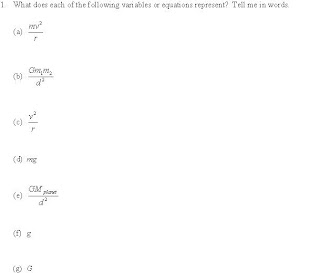The drawing shows a PV diagram in which a gas expands at constant pressure from A to B, and then goes from B to C at constant volume. Determine the signs of ΔU, Q, and W for each of the two processes. Justify your answers.
This is the first PV diagram question which I assign in my honors or AP course. We have discussed the definitions of the variables in the first law, and how to determine the value of each variable from the PV diagram.*
*Including the fact that the value of Q cannot be determined directly from the diagram without using the first law.
The solution, in the language and logical order that I prefer:
A-B:
ΔU is positive, because the product of P and V is larger at point B than at point A.
W is negative, because the volume increased.
Q must be positive by the first law, Q = ΔU - W, (+) = (+) - (-)
B-C:
ΔU is positive, because the product of P and V is larger at point C than at point B.
W is zero, because the volume did not change (or because there is no area under the curve from B to C)
Q must be positive by the first law, Q = ΔU - W, (+) = (+) - (0)
Note that I'm not yet asking for any quantitative answers. That's too much for the first problem set. I try to get my class totally comfortable identifying facts, assigning signs, and using the correct vocabulary for each term before I ask for numerical answers.
Also, look how straightforward the answers. ΔU is (3/2)PV; W is the area under the curve; and Q is determined from the first law. It takes a lot of effort on my part to get students disciplined enough to used this approach. They invariably want to, somehow, somewhere, talk about "molecules moving around:" "Q is positive because when the pressure increases, the molecules have to move around a lot faster, leading to more heat." Such a statement is worse than nonsense. PV diagrams refer to macroscopic systems, and must be interpreted with reference to relevant equations and facts, only.
This year, anticipating the difficulty of convincing students to use a disciplined, macroscopic approach to the first law of thermodynamics, I promised that the penalty for any reference to "molecules moving around" in a first law justification would earn double points off. And sure enough, I had a student who lost double credit on this very problem. But only one this year...


















